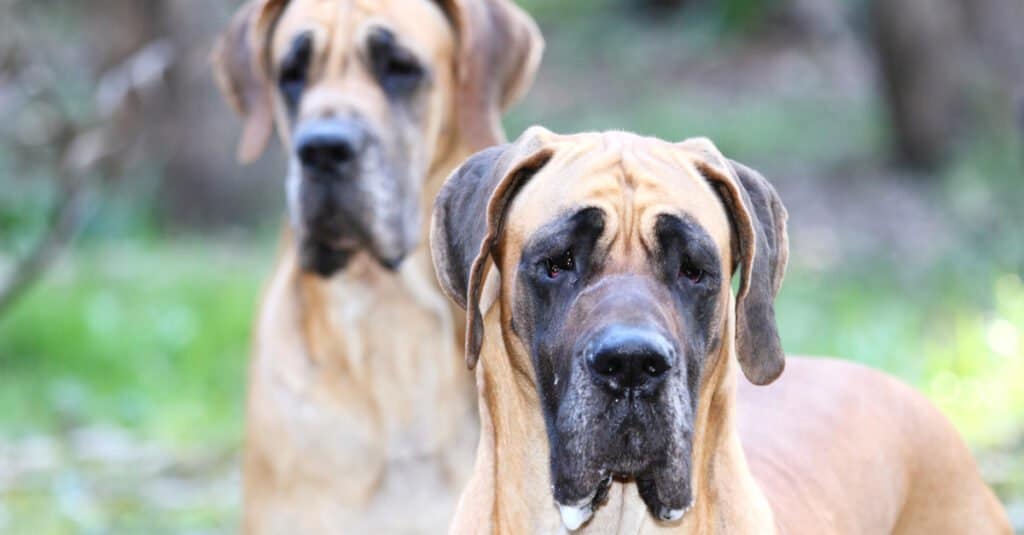What is a dog’s age in human years? Your dog’s current age is the most decisive determining factor. Many people were taught that using this information to determine a dog’s “human age” is simply a matter of multiplying the dog’s age by seven. This is actually not accurate. Correctly approximating a dog’s place in the human life span will take a little more calculation.
In fact, a dog’s first year adds up to 15 human years, and then the second year adds nine years. Each subsequent year after the second adds about five years. Some breeds also age differently, which makes calculating age less precise in some cases.
Your Under 12 Month-Old Dog’s Age in Human Years: 15

These high-energy pups are learning everything from potty training to understanding their place in the pack.
©Rita_Kochmarjova/Shutterstock.com
During the first year of its life, a dog will reach the equivalent of 15 human years. By the time a dog is a year old, it has at least reached adolescence. The size of the breed will determine how much a dog matures in its first year. Generally speaking, a small or toy-sized dog will have reached maturity at this age, while a giant breed will still be growing.
The first year of a dog’s life will see many changes as the dog transitions from babyhood to young adulthood. Puppies of all breeds are going through phases to learn their place within their family, or “pack.” Younger puppies will have a high energy level and go through stages with a lot of chewing because of teething.
Most puppies will start to calm down a little as they grow out of their teething stage. Once they are past the teething stage, they will be approaching another milestone in the form of puberty. Smaller breeds like Chihuahuas may be ready to breed in their first year, while the Great Pyrenees may not reach sexual maturity until two or three.
Once a dog has reached its first birthday, it will have an adult appearance. As with human teenagers, dogs may continue to grow and fill out a bit after reaching this stage. However, they are considerably more mature than young puppies and will behave more like adult dogs.
Your 2-Year-Old Dog’s Age in Human Years: 24

By its second birthday, a dog is considered a full-grown adult.
©kimberly petts/Shutterstock.com
Once a dog reaches its second year, it is a full adult. The appearance, including the coat, will be the adult appearance that the dog will retain for most of its life. Larger breeds, particularly those considered giant-sized, will often not have their first heat cycles until their second year.
Although a dog of this age is still very energetic, some of the hyper behavior often associated with puppyhood will have died down. Dogs of this age used for working or hunting purposes will have the attention span and focus required for their appointed tasks. Once dogs have gotten into adulthood, they are more reliable family companions.
During most of a dog’s adult years, it will be in prime physical and mental condition. Most breeds age an average of five human years each year, starting with their third year. Some age more slowly because of their small size, while others age quicker because of their large size.
Some dog breeds also come from breeding or show lines that may impact how quickly they age. Dogs bred from working lines often live longer and may age somewhat more slowly. When dogs come from poorly-bred lines, they may be slightly more susceptible to age-related issues in life.
Middle Age for Most Dogs: 4 to 6 Years

Due to their enormous size, Great Danes are one of the larger breeds that reaches maturity at an earlier age.
©Jesus Souto/Shutterstock.com
The size of a breed will determine when a dog is considered middle-aged. Great Danes, because of their large size, are often considered middle-aged as early as four. Four to six years old in dogs translates to 34 to 44 in human years.
Middle-aged dogs have a lower activity level than their younger counterparts. However, they are still able to perform most of the tasks demanded of them at this age. Many dogs from working breeds are highly functional into middle age and beyond.
When Most Dogs Are Considered Seniors: 8 to 11 Years

A pup is typically considered a senior between 8 and 11 years of age.
©Alex Mladek/Shutterstock.com
Although many will behave more like middle-aged dogs, most larger dogs are regarded as seniors as early as age eight. Medium-sized dogs are considered seniors at age ten, while the smallest breeds are considered seniors at 11.
When dogs reach the senior phase in their lives, they are likely to have visible gray hairs on their faces. Gray hair can also be seen throughout other areas of the dog’s coat. On some dogs, these hairs will eventually turn white.
Dogs will usually have a decrease in their activity levels around this age. Although an older dog in good health will be somewhat active, the activity level of youth and middle age is unlikely. Age-related health problems are more common in the senior than middle-aged years.
Possible Exceptions to the Aging Process: Smaller Toy Breeds and Giant Breeds

Teacup breeds tend to have shorter lifespans due to breeding.
©DOPTOON/Shutterstock.com
Two types of dogs may age somewhat faster than others due to reduced lifespans. One case involves toy-sized dogs bred to “teacup” size, such as smaller Chihuahuas and Yorkshire Terriers, who may live seven to 12 years instead of the 14- to 15-year lifespan that is more typical of these breeds. Another example is in the case of some giant breeds, including Great Danes and Irish Wolfhounds, many of whom are lifespans as low as six to seven years.
Dogs that are exceptionally smaller or larger are often the product of breeding from a very limited gene pool. Because a smaller group of dogs makes up their bloodlines, they have a higher chance of inheriting certain conditions. Teacup-sized toy dogs may age faster than others of their breeds, while giant-sized dogs are at a faster rate than dogs of other sizes, consistent with their shorter lifespan.
Up Next:
Keep deepening your pet knowledge by checking out these fact-filled articles.
- How Old is My Cat In Human Years? – Now, see how felines compare to people as they age. You’ll also learn how environmental factors impact a cat’s aging.
- Can Dogs Tell When You’re Sad? – There might be more behind the answer to this question than you think! Learn about the fascinating emotional connections dogs can form with their owners.
- Why Does My Dog Stare at Me (A Real Explanation) – Discover the possible answers to this age-old question about dogs. And, learn when you should be concerned about that canine glare.
The photo featured at the top of this post is © TanyaCPhotography/Shutterstock.com
Ready to discover the top 10 cutest dog breeds in the entire world?
How about the fastest dogs, the largest dogs and those that are -- quite frankly -- just the kindest dogs on the planet? Each day, AZ Animals sends out lists just like this to our thousands of email subscribers. And the best part? It's FREE. Join today by entering your email below.
Thank you for reading! Have some feedback for us? Contact the AZ Animals editorial team.







